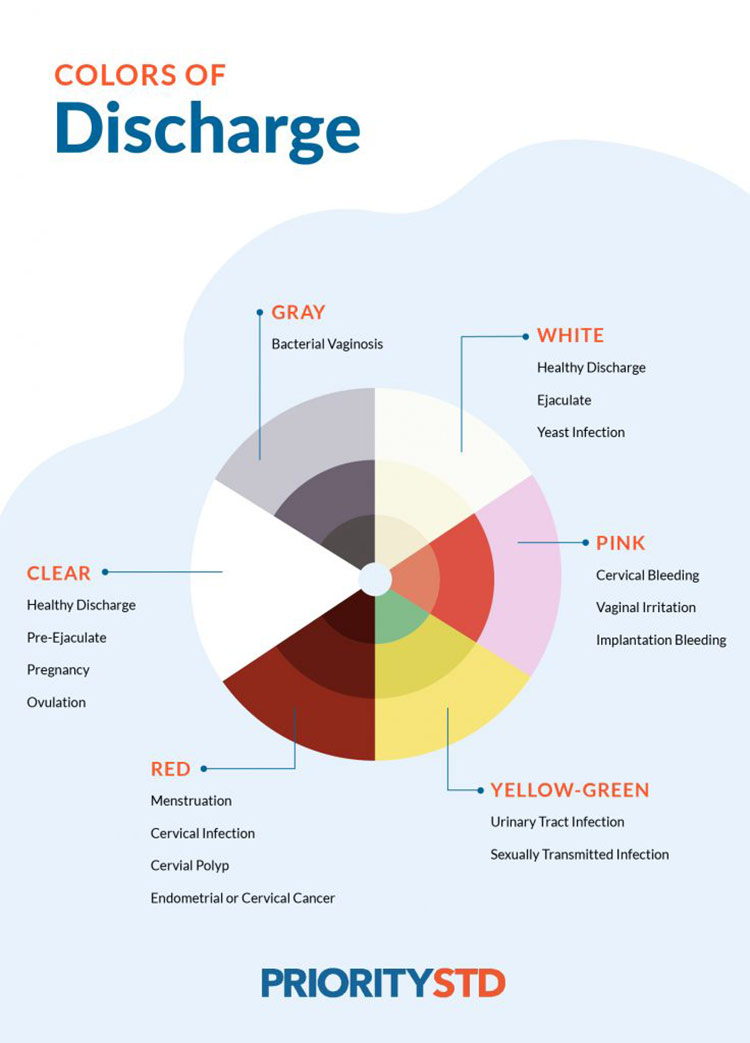Unusual STD discharge is certainly one of the more common STD symptoms people think of when it comes to sexually transmitted diseases. And largely because of that very reason, it’s easy to panic or fear the worst at the first sign of any kind of irregularity surrounding the genital region. It’s worth noting, however, that discharge from the penis or vagina is not always a tell-tale sign that you’ve contracted an STD. In fact, certain discharges are perfectly normal and nothing to worry about.
STD Discharge
If your discharge is the result of an STD, not to worry. Even the STDs known to cause STD discharge can be cured fairly easily and painlessly if caught early enough. So before getting yourself all worked up, you’ll want to know a little more about what STDs (and non-STD conditions) cause vaginal and penile discharge and when you need to take action to get it taken care of.
STD Discharge Color Chart
As you can see, there are many different types, colors, and consistencies when it comes to STD discharge and non-STD discharge. Often infections will cause similar symptoms in men and women, but such is not always the case. For that reason, let’s take a minute to differentiate between vaginal discharge and penile discharge.
Vaginal STD Discharge
Certain types of vaginal discharge are perfectly normal, healthy, and in fact necessary to keep the vagina clean and protected. It is normal for these types of clear or milky discharges to increase during sexual arousal and ovulation. During pregnancy, it is common for these types of discharges to increase both in frequency and volume. And when estrogen levels decrease due to menopause, medications, treatments, or other factors, it is normal for vaginal discharge levels to decrease.
A normal, healthy discharge will range in color from clear to milky white and will generally have only a slight odor. If color is more prominent (yellow or green for instance) it could be a sign of a bacterial infection or sexually transmitted disease. These types of discharges may have a more potent, fishier smell to them as well. In these instances, you’ll want to take the necessary steps and get tested for STDs. As unusually-colored or foul-smelling vaginal discharge can be indicative of several STDs, we recommend going with a panel option and getting tested for multiple STDs all in one visit.
Though not STD-related, you’ll also want to keep an eye out for brown vaginal discharge which could be caused by irregular period cycles and may be a sign of uterine or cervical cancer. Thick and painful discharge, the consistency of cottage cheese for example, can be a sign of a yeast infection. In either of these cases, you’ll want to consult with your physician as far as the best treatment regimen.
Penile STD Discharge
Generally, any kind of penile discharge (that is, anything other than semen, pre-ejaculate, or urine) is worth looking into or discussing with a medical professional. That’s not to say that any sign of penile discharge is an immediate cause for alarm, but you will want to get it checked out and seek out the proper treatment options.
A white or yellow discharge from the penis can be a sign of a bacterial infection or STD. Often, when these types of discharges are apparent, you’ll notice a mild or intense burning sensation during urination. If you’re experiencing such, you’ll want to get tested immediately and, if necessary, get on the proper treatment regimen. And of course, if you do test positive, you’ll want to notify any recent sexual partners so that they can get tested as well.
Non-STD causes of penile discharge can include urinary tract infections or prostatitis (inflammation of the prostate). Like an STD, a urinary tract infection will often cause pain while urinating, itching, or tenderness in the genital region in addition to unusual penile discharges. Prostatitis may cause one to have difficulty urinating, pain while ejaculating, or blood in the urine stream. Either of these conditions is easily curable with the right prescription medication, but you will want to consult with your physician when you first suspect something may not be right. If left untreated, these conditions may worsen.
What STDs Cause Discharge
For sexually active men and women experiencing unusual vaginal or penile discharge, a sexually transmitted disease can certainly be the cause. Along with burning or pain during urination, unusual discharge is probably one of the more commonly known signs of an STD. But remember, many STDs display no indicators, whatsoever so it is always a good idea to practice safe sex and get tested regularly even if signs are not apparent.
Below are the most common STDs known to cause unusual discharge:
Trichomoniasis
Both women and men may experience an unusual discharge from the vagina or urethra1. In women, this may be frothy and carry a strong, fishy odor. Discharges may be white, yellow, green, or gray in color. Typically, a person with trichomoniasis that notices a discharge from the genitals will also experience pain during urination or intercourse and redness, burning, and/or itching around the infected areas as well. These symptoms are not unique to trichomoniasis, so if you’re experiencing one or more of these indications, you may want to get tested for multiple STDs just in case. Trichomoniasis is often asymptomatic, and women are more likely than men to develop any signs.
Chlamydia
Though asymptomatic most of the time, chlamydia can also cause thick, yellow or white discharge in men and women2 as well as painful or frequent urination and pain during intercourse. Fortunately, chlamydia is easily curable if caught and treated in a timely fashion. If you experience any of these manifestations, or if you believe you’ve been exposed by way of an infected partner, you’ll want to get tested and (if necessary) treated properly.
Gonorrhea
Like those mentioned before, gonorrhea is most often asymptomatic and can be passed from one person to another by way of sexual intercourse. However, when signs are present, they may include increased vaginal discharge or pus-like penile discharge 3 often white or yellow in color. Painful urination, pain during intercourse, or even pain during bowel movements can be indicative of gonorrhea as well. As is the case with other STDs, you’ll want to get tested if you are experiencing any of these indicators or if you believe you’ve been exposed by a sexual partner. If caught early enough, gonorrhea is easily curable with the proper medication.
If you’re one to start frantically doom Google searching at the first sign of penile or vaginal discharge, don’t. It’s important to take a step back and know that whatever is causing your discomfort, it is likely treatable and curable. It’s never a bad idea to seek out reputable STD testing centers if you develop symptoms or suspect you’ve been exposed, nor is it ever ill-advised to consult with your physician who will be able to diagnose you and get you on the path to wellness. Non-STD or STD discharge might be a little uncomfortable or downright embarrassing to discuss, even with your physician, but doing so can ensure your health and the health of those you love.
Sources
- Trichomoniasis. (2020, April 18). Retrieved February 12, 2021, from https://www.mayoclinic.org/diseases-conditions/trichomoniasis/symptoms-causes/syc-20378609
- Chlamydia trachomatis. (2020, February 20). Retrieved February 12, 2021, from https://www.mayoclinic.org/diseases-conditions/chlamydia/symptoms-causes/syc-20355349
- Gonorrhea. (2019, December 06). Retrieved February 12, 2021, from https://www.mayoclinic.org/diseases-conditions/gonorrhea/symptoms-causes/syc-20351774

